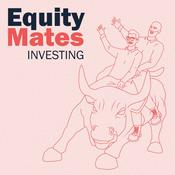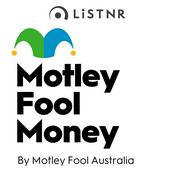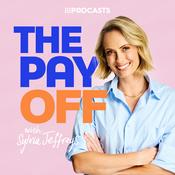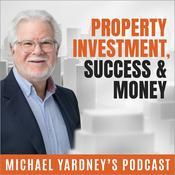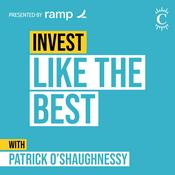492 episodes

Ep 388: Wealth First Principles #1: How wealth is actually built – The Wealth Equation
23/12/2025 | 34 mins.
Read Full Blog HereStuart opens with Wealth First Principles, explaining how real fortunes are built through three key inputs: a durable cash-flow surplus, investment efficiency (quality assets, low costs, smart tax structures, and few behavioral errors), and time (the compounding decade that does most of the work). He separates process from prediction, shows why speculation usually fails, and explains where leverage helps (sensible gearing on high-quality property with buffers) versus where it can harm (aggressive equity leverage). The mindset shift: ignore stories, automate saving, and let compounding do the heavy lifting.Then he applies the framework to a detailed 10–15-year property plan: upgrading into an Adelaide family home later while renting it first, managing an existing regional PPOR, and deciding whether to sell or hold an inner-metro investment. Stuart stress-tests IO vs P&I for a decade, preserving deductible debt with offsets, optimal ownership splits for tax, and DTI/borrowing-capacity risks. He covers sequencing (buy vs renovate vs super), cash-flow resilience, buffers, and the realities of market timing in Adelaide. Practical guardrails include de-linking securities (avoiding cross-collateralization), structuring loans to maintain flexibility, and using evidence-based criteria to ensure each new asset is unequivocally investment-grade. The takeaway: anchor decisions to surplus, efficiency, and time, and design the debt so your future choices stay open.Subscribe via www.investopoly.com.au/emailDo you have a question? Email: [email protected] or for a faster response, post a comment on the episode's video over on YouTube: https://www.youtube.com/@investopolypodcast/podcasts If you're interested in working with my team and me, discover how we can work together here: https://prosolution.com.au/prospective-client/If this episode resonated with you, please leave a rating on your favourite podcast platform. Subscribe to my weekly blog: https://www.prosolution.com.au/stay-connected/ Buy a one of Stuart's books for ONLY $20 including delivery. Use the discount code blog: https://prosolution.com.au/books/DOWNLOAD our 97-point financial health checklist here: https://prosolution.com.au/download-checklist/IMPORTANT: This podcast provides general information about finance, taxes, and credit. This means that the content does not consider your specific objectives, financial situation, or needs. It is crucial for you to assess whether the information is suitable for your circumstances before taking any actions based on it. If you find yourself uncertain about the relevance or your specific needs, it is advisable to seek advice from a licensed and trustworthy professional.

Super vs Flexibility, Debt vs Growth: Q&A on Contributions, Gearing, and Renovation Timing
22/12/2025 | 27 mins.
In this Q&A, Stuart unpacks two meaty, real-world dilemmas that many high-earning families face. First: should you prioritise concessional super contributions (carry-forward caps, Div 293 awareness, and long-term compounding) or keep capital outside super for flexibility and early semi-retirement? We explore building a liquid “bridge” portfolio, how to structure debt so renovation and investment loans stay deductible, and why borrowing to fund improvements paired with offset cash preserves future options.Next, we stress-test a fast-growing portfolio: a dream PPOR on acreage, a premium Geelong West IP, and an impending second purchase in inner-west Melbourne. Stuart tackles sequencing (buy vs renovate vs super), risk concentration at 80% LVR, cash-flow resilience through cycles, and the hidden traps of cross-collateralisation. We also cover trust distributions to a high-income household, return-on-payroll for a construction business, and the checklist for green-lighting IP #2 without jeopardising the 4–5 year, $1–1.5m renovation.The through-line: optimise for flexibility and durability, use super where it clearly wins on tax and compounding, keep enough liquidity to sleep at night, and make each new asset unquestionably investment-grade.Subscribe via www.investopoly.com.au/emailDo you have a question? Email: [email protected] or for a faster response, post a comment on the episode's video over on YouTube: https://www.youtube.com/@investopolypodcast/podcasts If you're interested in working with my team and me, discover how we can work together here: https://prosolution.com.au/prospective-client/If this episode resonated with you, please leave a rating on your favourite podcast platform. Subscribe to my weekly blog: https://www.prosolution.com.au/stay-connected/ Buy a one of Stuart's books for ONLY $20 including delivery. Use the discount code blog: https://prosolution.com.au/books/DOWNLOAD our 97-point financial health checklist here: https://prosolution.com.au/download-checklist/IMPORTANT: This podcast provides general information about finance, taxes, and credit. This means that the content does not consider your specific objectives, financial situation, or needs. It is crucial for you to assess whether the information is suitable for your circumstances before taking any actions based on it. If you find yourself uncertain about the relevance or your specific needs, it is advisable to seek advice from a licensed and trustworthy professional.

Ep 387: Should you be an active property investor if your budget is under $1m
16/12/2025 | 37 mins.
Read Full Blog HereIn this episode, Stuart makes the case for becoming a value-add property investor when budgets are tight. Rather than stretching for a bigger dwelling in a weaker location, he argues for prioritising high land value in an A-grade area and accepting a tired home you can improve. He outlines the highest-ROI upgrades (kitchens, bathrooms, paint, flooring, efficient heating/cooling; and, where sensible, adding a third bedroom), how these boost rent and reduce vacancy, and the smart way to fund works by borrowing the renovation cost and park cash in an offset to preserve flexibility and deductions. He clarifies the distinction between repairs and improvements (immediate deduction vs. depreciation), why a depreciation schedule is important, and the role of a seasoned local buyer’s agent in avoiding costly missteps.In the Q&A, Stuart tackles two big listener themes. First: simplifying a messy mix of assets to maximise retirement income, define required spending, prioritise tax-free super income streams, rebalance from low-yield positions to diversified income, and set a clear drawdown plan with adequate cash buffers. Second: navigating a rezoning/subdivision opportunity on a large primary residence, how main-residence CGT rules interact with a prior rental period, when profits can be taxed on revenue account, GST considerations, timing if purchasing another home, and choosing between an outright sale to a developer or a JV. He also lists the advisory bench needed: property accountant, tax lawyer, town planner, valuer, and development project manager.Subscribe via www.investopoly.com.au/emailDo you have a question? Email: [email protected] or for a faster response, post a comment on the episode's video over on YouTube: https://www.youtube.com/@investopolypodcast/podcasts If you're interested in working with my team and me, discover how we can work together here: https://prosolution.com.au/prospective-client/If this episode resonated with you, please leave a rating on your favourite podcast platform. Subscribe to my weekly blog: https://www.prosolution.com.au/stay-connected/ Buy a one of Stuart's books for ONLY $20 including delivery. Use the discount code blog: https://prosolution.com.au/books/DOWNLOAD our 97-point financial health checklist here: https://prosolution.com.au/download-checklist/IMPORTANT: This podcast provides general information about finance, taxes, and credit. This means that the content does not consider your specific objectives, financial situation, or needs. It is crucial for you to assess whether the information is suitable for your circumstances before taking any actions based on it. If you find yourself uncertain about the relevance or your specific needs, it is advisable to seek advice from a licensed and trustworthy professional.

Family property transfers, rising insurance premiums, and where to deploy surplus cash: Q&A on tax, debt, and long-term strategy
15/12/2025 | 31 mins.
In this Q&A episode, Stuart works through a series of nuanced listener questions that all sit at the intersection of tax, structure, and long-term decision making. While the scenarios vary, the common thread is the cost of getting the structure wrong early, and the difficulty of undoing it later.We begin with a Melbourne couple in their 30s navigating a generous but complex proposal from ageing parents: the potential transfer of an investment property that may become a future family home. Stuart unpacks the trade-offs between gifting now versus inheriting later, the often-overlooked capital gains and stamp duty consequences, and why emotional intent does not override tax law. The discussion highlights how building, ownership, and funding decisions interact over decades, not just at the point of transfer.Next, Stuart addresses a listener holding a legacy agreed-value income protection policy. With premiums rising sharply, the focus turns to how to think about policy add-ons, what actually protects long-term earning capacity, and why some features feel comforting but deliver little real value relative to their cost.The episode then shifts to a detailed portfolio question from a high-income family weighing multiple competing uses of surplus cash flow: renovating the family home, upgrading, buying more property, investing in shares, or accelerating super contributions. Stuart reframes the decision away from “which option is best” and towards understanding opportunity cost, borrowing constraints, and the difference between emotional returns and financial ones. Inflation, real versus nominal returns, and the illusion of certainty in long-term projections are all addressed.We also explore whether recycling equity from investment properties to pay down a principal place of residence actually works in practice. Stuart explains the tax mechanics, where investors commonly trip up, and why some popular strategies sound elegant in theory but are messy or counterproductive in reality.As always, the episode is less about definitive answers and more about building a framework for making better decisions when the stakes are high, the numbers are large, and the consequences are long-lasting.Subscribe via www.investopoly.com.au/emailDo you have a question? Email: [email protected] or for a faster response, post a comment on the episode's video over on YouTube: https://www.youtube.com/@investopolypodcast/podcasts If you're interested in working with my team and me, discover how we can work together here: https://prosolution.com.au/prospective-client/If this episode resonated with you, please leave a rating on your favourite podcast platform. Subscribe to my weekly blog: https://www.prosolution.com.au/stay-connected/ Buy a one of Stuart's books for ONLY $20 including delivery. Use the discount code blog: https://prosolution.com.au/books/DOWNLOAD our 97-point financial health checklist here: https://prosolution.com.au/download-checklist/IMPORTANT: This podcast provides general information about finance, taxes, and credit. This means that the content does not consider your specific objectives, financial situation, or needs. It is crucial for you to assess whether the information is suitable for your circumstances before taking any actions based on it. If you find yourself uncertain about the relevance or your specific needs, it is advisable to seek advice from a licensed and trustworthy professional.

Ep 386: Which is better: REIT or direct property?
09/12/2025 | 33 mins.
Read Full Blog HereIn this episode, Stuart pulls apart the perennial “REITs vs direct property” debate and shows why they’re not substitutes but tools for different jobs. He explains how A-REITs work (structures, stapled securities, payout rules, typical 30–40% gearing) and why their liquidity and ~5% income appeal can be offset by equity-like volatility and index concentration (think one or two giants driving returns). He contrasts this with direct residential property: full control, the ability to gear up to 100%, negative-gearing benefits while working, lower observed volatility, and returns dominated by capital growth, making it a more potent long-term wealth builder when you buy true investment-grade assets. Stuart compares long-run numbers: REITs ~6–8% p.a. with higher year-to-year swings versus quality residential property targeting ~8%+ with smarter selection and sensible leverage. He then reframes their roles: REITs can be an income sleeve (especially when rates are low), while direct property is fundamentally a growth engine. In the listener Q&A, Stuart clarifies tax treatment for “informal trust” share portfolios for minors who are taxed on income, the pitfalls of penal child tax rates, and what actually triggers CGT when transferring to an adult at 18 cutting through conflicting internet guidance so parents don’t make costly ownership-structure mistakes.Subscribe via www.investopoly.com.au/emailDo you have a question? Email: [email protected] or for a faster response, post a comment on the episode's video over on YouTube: https://www.youtube.com/@investopolypodcast/podcasts If you're interested in working with my team and me, discover how we can work together here: https://prosolution.com.au/prospective-client/If this episode resonated with you, please leave a rating on your favourite podcast platform. Subscribe to my weekly blog: https://www.prosolution.com.au/stay-connected/ Buy a one of Stuart's books for ONLY $20 including delivery. Use the discount code blog: https://prosolution.com.au/books/DOWNLOAD our 97-point financial health checklist here: https://prosolution.com.au/download-checklist/IMPORTANT: This podcast provides general information about finance, taxes, and credit. This means that the content does not consider your specific objectives, financial situation, or needs. It is crucial for you to assess whether the information is suitable for your circumstances before taking any actions based on it. If you find yourself uncertain about the relevance or your specific needs, it is advisable to seek advice from a licensed and trustworthy professional.
More Business podcasts
Trending Business podcasts
About Investopoly
Listen to Investopoly, The Prof G Pod with Scott Galloway and many other podcasts from around the world with the radio.net app

Get the free radio.net app
- Stations and podcasts to bookmark
- Stream via Wi-Fi or Bluetooth
- Supports Carplay & Android Auto
- Many other app features
Get the free radio.net app
- Stations and podcasts to bookmark
- Stream via Wi-Fi or Bluetooth
- Supports Carplay & Android Auto
- Many other app features


Investopoly
download the app,
start listening.





